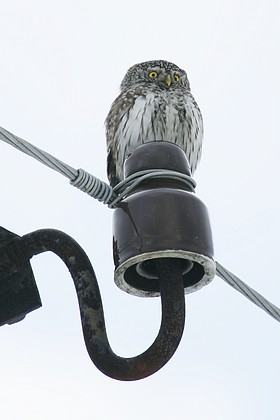Like a doll -pygmy owl
Photo: Arne Ader
Translation: Liis
Electric atmosphere! Pygmy owl.
Pygmy owl Värbkakk Glaucidium passerium
Trees have lost their leaves, with cloudy weather evening arrives already halfway through the day. A period in all ways suitable for meeting the pygmy owl, Europe’s smallest owl.
In addition to "our own“ birds, species comrades have slowly gathered, mostly young birds from the north and east. As late autumn advances they move closer to human settlements. As an estimate the winter number of pygmy owls in some years reaches over a couple of thousand individuals.
Both sexes of pygmy owls have similar plumages all year round. Full-grown female birds are a bit larger than males. The beak and large eyes are yellow, brow streaks light. Flight view is soft and undulating. The plumage of young birds passes different development phases but the size leaves no doubt about species.
They are busy in evening and morning dusk, having more daytime habits than the larger owls – being hidden at night is prudent with regard to larger predators.
They keep watch for prey at the border between open and forested land or thicket, sometimes quite openly on a dried branch stump or spruce top. Barely some twenty centimetres tall, and a pygmy owl frozen in place might not be noted in spite of the open perching.
Pygmy owls feed as birds of prey do: passerines and rodents. Not particularly shy of people, let themselves be observed nicely. The hunting of pygmy owls and the behaviour of their prey is interesting to watch.









